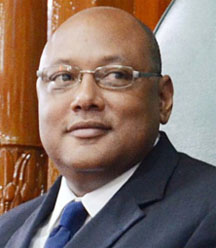Purchases of gold by the Guyana Gold Board (GGB) declined by a whopping 20.5% last year over 2014, according to information contained in the Board’s 2015 Report. The Report says that last year the GGB purchased 146,158.3 ounces of gold compared with 186,894.1 ounces in 2014.
Smuggling and departures from the gold fields because of the low gold price are seen as the reasons behind the drop.
Earlier this month Natural Resources Minister Raphael Trotman told the media that as much as 15,000 ounces of gold is being smuggled out of the country each week, a practice which he said has attracted the attention of the US Federal Bureau of Investigation and the Department of Homeland Security.

In 2015 144,132.9 ounces of gold valued at US$154,667,571 was exported by the GGB for refining, a decline over the 2014 period when 182,345.4 ounces valued at US$214,504.187 was exported. The total export value of all gold exported last year was US$501,131,764, a 6.7% growth in exports over 2014, a development which the Board said came primarily from the exports of the two foreign-owned large-scale mines, Troy Resources and Guyana Goldfields which began operating in the last quarter of 2015. It said that in the absence of those contributions the export value of gold amounted to US$458,525,359, a decline of 2.4% over the same period last year, driven largely by a “price decline.”
The GCB says, meanwhile, that the 450,873-ounce gold declaration for last year topped the declaration for 2014 by 16.3 % with the Board and its licensed dealers contributing 411,382 ounces or 91.2%. At the start of 2015, its holding of gold stood at 11,846.92 ounces and ended with a total holding of 50,166.07, a more than threefold increase in gold stock.
The setbacks resulting from smuggling apart, the Board says that it began last year “in a volatile external market” with prices fluctuating from an average high of US$1,295.75 an ounce in January and slipping to an average low of US$1053.03 on December 3 last year.
Smuggling and gold prices apart, the GGB faced other challenges in 2015 including its failed attempt to comply fully with the requirements of the Financial Intelligence Unit (FIU) in remitting to the Unit threshold reports for the individuals and entities that sold gold above the value of US$2m. The GCB says that the FIU had objected to the reports on the “incomplete identification” on several gold sellers. The Board has said that its failure to comply fully with the FIU’s requirements is a function of computer software limitations that restrict its ability to provide the details required by the FIU. The Board says that it is in the process of developing new Gold Purchase Management Software with features that would be more responsive to the FIU’s requirements which it says will be implemented during the first quarter of this year.
Additionally, the GGB says that some miners who sell gold over the US$2m threshold are reluctant to repeatedly furnish the GGB with their identification document.
In December, Trotman was forced the intervene with the Bank of Guyana after it had notified the GCB that it had slipped into overdraft totaling in excess of $12 billion and that it would not extend the overdraft facility beyond January 4 this year, a step which the GGB said would have effectively “shut down” its operations. Earlier, in September 2015, the Bank of Guyana had reportedly stepped in to allow the GGB to access its account in order to pay miners after the Accountant General had reportedly put a brake on withdrawals from the Consolidated Account as it was in deficit to the tune of more than $8 billion. The GGB’s recent report indicates that the matter of its overdraft with the Consolidated Fund remains unsettled despite a meeting with the Finance Secretary and the Accountant General and that it requires “significant attention.”





